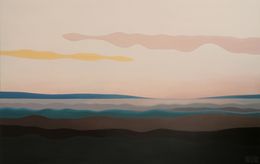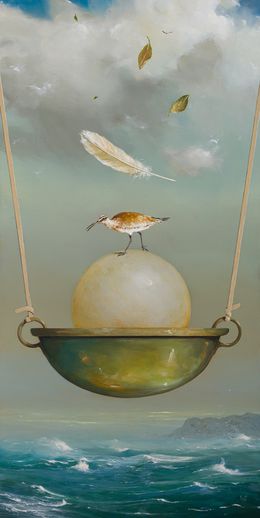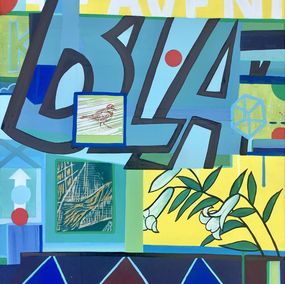
Landscape Painting for Sale
Save your search and find it in your favorites
Save your search to find it quickly
Saved search
Your search is accessible from the favorites tab > My favorite searches
Unsaved search
A problem occurred





Requiem for Missing Ships
Dimitar Cholakov
Painting - 110 x 70 x 3 cm Painting - 43.3 x 27.6 x 1.2 inch
$1,566


À la rencontre du printemps
Diana Malivani
Painting - 150 x 120 x 4 cm Painting - 59.1 x 47.2 x 1.6 inch
$15,657


Sans titre - série paysage et végétal
Muriel Hériveau
Painting - 60 x 80 x 4 cm Painting - 23.6 x 31.5 x 1.6 inch
$1,113


Tempête sur la ville - Paysage abstrait
Michel Jamet
Painting - 80 x 80 x 2 cm Painting - 31.5 x 31.5 x 0.8 inch
$2,030


Avocado House in Volcanic Ash
Christopher Burk
Painting - 20.3 x 20.3 x 5.1 cm Painting - 8 x 8 x 2 inch
$1,440



Tempête tropicale - Paysage abstrait
Nicole Gérard
Painting - 92 x 73 x 2 cm Painting - 36.2 x 28.7 x 0.8 inch
$1,595

Ciel flamboyant Ref BDNW10739
Jacques Poncet
Painting - 50 x 65 cm Painting - 19.7 x 25.6 inch
$1,740





Allées et venues en paysage moelleux n°3
Éléonore Deshayes
Painting - 100 x 100 x 3 cm Painting - 39.4 x 39.4 x 1.2 inch
$4,639





Les Coquelicots d'hiver
Aimée De Courtozé
Painting - 30 x 30 x 2 cm Painting - 11.8 x 11.8 x 0.8 inch
$371


The end of that day, Painting, Oil on canvas
Elohim Sanchez
Painting - 76.2 x 121.9 x 2 cm Painting - 30 x 48 x 0.8 inch
$2,060



Grand paysage lacustre 3
Sébastien Couëffic
Painting - 89 x 116 x 3 cm Painting - 35 x 45.7 x 1.2 inch
$2,783



Le pont II
François-Xavier de Boissoudy
Painting - 100 x 125 x 2 cm Painting - 39.4 x 49.2 x 0.8 inch
$7,539

248-Mort et Lumières
Jacques Resch
Painting - 80 x 60 x 1 cm Painting - 31.5 x 23.6 x 0.4 inch
$5,799

Golden Thicket
Lorna Holdcroft - Kirin
Painting - 100 x 100 x 4.5 cm Painting - 39.4 x 39.4 x 1.8 inch
$2,786




L'enfant du marais
Eric Roux-Fontaine
Painting - 81 x 100 x 4 cm Painting - 31.9 x 39.4 x 1.6 inch
$10,322






Ngapa Jukurrpa (Water Dreaming) - Puyurru
Nazareth Collins Jangala
Painting - 40 x 40 cm Painting - 15.7 x 15.7 inch
$580


El Bosque De Los Mitos. From The Series Of Revelación,
Daniel Casique
Painting - 75 x 60 x 5.1 cm Painting - 29.52 x 23.62 x 2 inch
$2,500









Saint-Rémy de Provence
André Hambourg
Painting - 28 x 35 x 2 cm Painting - 11 x 13.8 x 0.8 inch
$6,727


De la série 'Motherland' N°918
Hossein Khoshraftar
Painting - 139 x 118 x 5 cm Painting - 54.7 x 46.5 x 2 inch
$4,639


Grand canal de nuit à Venise
Christine Jacquel
Painting - 33 x 40.9 x 2 cm Painting - 13 x 16.1 x 0.8 inch
$1,259









Le mas de Gros Jean
Michèle Delimeux
Painting - 92 x 73 x 5 cm Painting - 36.2 x 28.7 x 2 inch
$2,436


La manchuella Florecida
Ulpiano Carrasco
Painting - 120 x 120 cm Painting - 47.2 x 47.2 inch
$12,178






Never-Ending Excursion
Naoko Shiozaki
Painting - 19 x 26.8 x 0.1 cm Painting - 7.5 x 10.6 x 0 inch
$1,459



En Provence, La Ste Victoire voit rouge - Paysage de Provence et champ de coquelicots
Myriam Colart
Painting - 50 x 65 x 2 cm Painting - 19.7 x 25.6 x 0.8 inch
$1,305






Les Calanques, encore une fois la mer
Gérard Ricard
Painting - 50 x 50 x 1 cm Painting - 19.7 x 19.7 x 0.4 inch
$1,276


Le ruisseau de Pombie - série Paysage et montagne
Robert Magendie Malo
Painting - 70 x 100 x 2 cm Painting - 27.6 x 39.4 x 0.8 inch
$1,595



Discover the styles & movements
Discover the selection of our experts
Landscape Painting for Sale
Throughout art history, landscape painting has remained a prominent art genre, alongside portrait and history painting. The desire to represent the natural world artistically has been shared across the world. Landscape painting can be found in Western art as well as in Asian works in China and Japan.
Despite the undeniable efforts made by artists from Antiquity until modern times to promote the genre, landscape painting only became truly established in the 15th and 16th centuries, thanks in part to the Flemish painter Joachim Pantiner who invented the world landscape. For the first time in Western art, nature became a subject for a painting in and of itself, not only as part of a great scene.
Another key factor that contributed to the development of landscape painting was the influence of the Protestantism in Holland. The protestant doctrine was hostile to religious iconography and forbade the use of biblical images which were feared to encourage idolatry.
Between the 16th and 17th century a group of Flemish and Dutch artists emerged who specialized in painting pastoral scenes, still lives and various kinds of landscapes. Autumnal landscapes, snow-covered landscapes, seascapes, garden and countryside landscapes were among the most popular.
For art historians, the French painter Claude Gellée, otherwise known as le Lorrain, stands out as the landscape artist who successfully gave more prestige to the genre. Artists such as Watteau, Vermeer and El Greco also helped to increase the genre's notoriety thanks to their very individual and unique styles.
From the 19th century onwards, landscape painting no longer needed to prove itself as a genre and it became much more than just a decorative art form. The majority of painters at the time were inspired by the genre's unique techniques and the number of landscape paintings produced equalled that of portraits. Watercolor was particularly popular.
The birth of photography in the 1850s and the development of Romanticism both helped to make nature an interesting choice of subject for an artwork. What's more, the Industrial Revolution led many artists to idolize nature as a supreme source of “truth" that was being lost and corrupted in the city. William Turner and Caspar David Friedrich made nature a figurative subject in their paintings and used it to express tormented feelings of melancholy and represent emotions in their purest form. Last but not least, influenced by the Orientalist movement, many artists glorified traveling to faraway lands, in search of exoticism among mysterious foreign landscapes.
In the 19th century Claude Monet revolutionized landscape painting with the Impressionist movement and marked a turning point in the genre's development. Monet emphasized the depiction of light in his works, rather than the likeness of the subject or the precision of the brushstroke. He also helped popularize plein air painting and often took his oil paints and canvases outside to paint the scene he had in front of his eyes. The landscape painting didn't have to resemble the subject but it tried to express the colors and the individual perception of the artist. We can also think about the Starry Night painting by Van Gogh.
In the 20th century, an array of art movements reinterpreted landscape painting, each in their own individual way. During this period, we often think of Piet Mondrian's symbolic windmills or the dark and lonely houses of the Realist artist Edward Hopper. The Cubists, the Surrealists and even abstract artists have all created landscape paintings.
In short, since the 19th century landscape painting has been established as a key genre, even if the desire to represent nature in all its various forms has not always been for the same reasons.
Explore our collection of modern and contemporary paintings and discover the range of landscape paintings that we have to offer, in acrylic paint, oil paint and more. You will find works from the likes of Hervé Di Rosa, Nicolas Fropo de Habart, Olle Svanlund and René-François Grégogna.
Landscape painting in art is a depiction of a landscape, or natural scenery, using the medium of paint. Landscape paintings may include elements such as hills, trees, fields, houses, mountains, and bodies of water.
The three main types of landscape painting are representational, impressionistic and abstract. While representational landscapes are the closest to mimicking reality, impressionistic and abstract landscapes aim to portray emotions or ideas through their colors, forms and compositions.
Landscape painting has played an important role in the history of art. It not only allows artists to depict the world and natural environment that they live in, but it also allows them to transmit their values and ideas about the place that they are depicting. For example, American landscape painting in the early 19th century celebrated the patriotic ideals of the American Revolution by glorifying its industrial expansion into a mythical American wilderness.









































